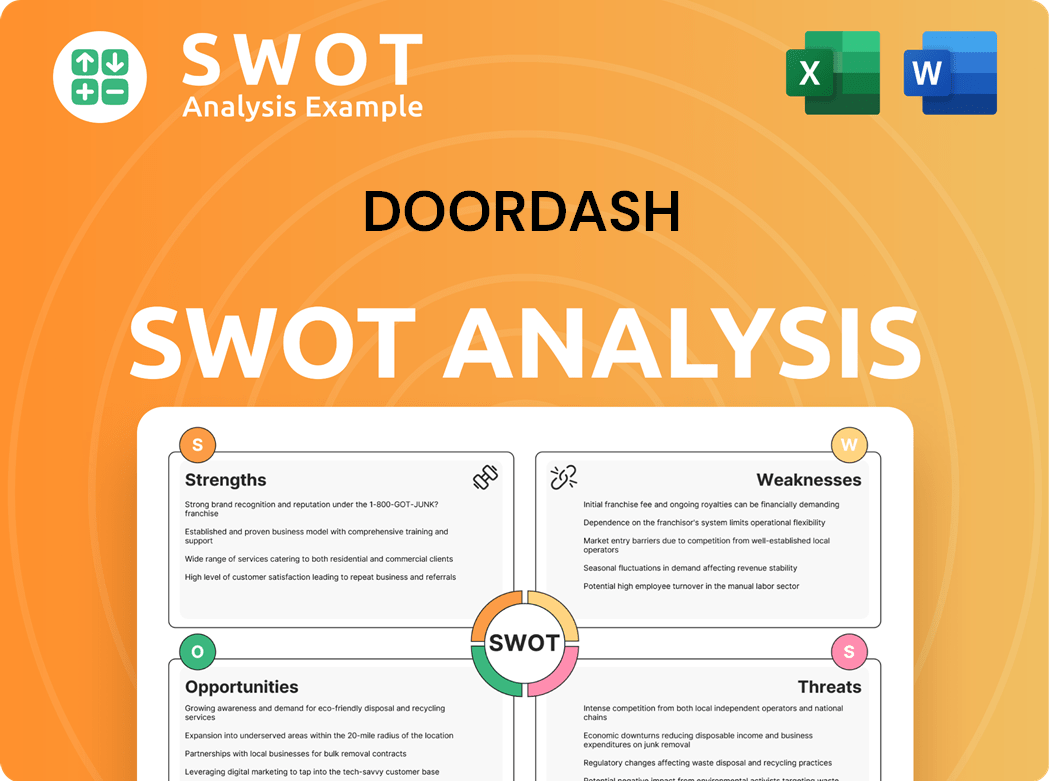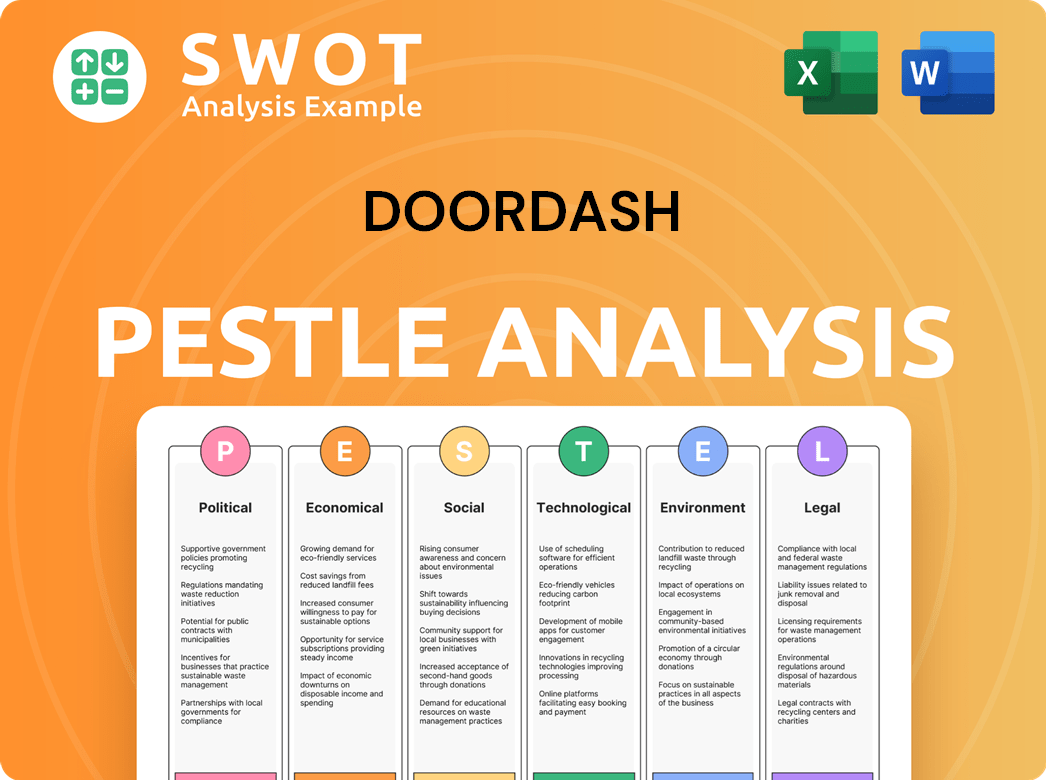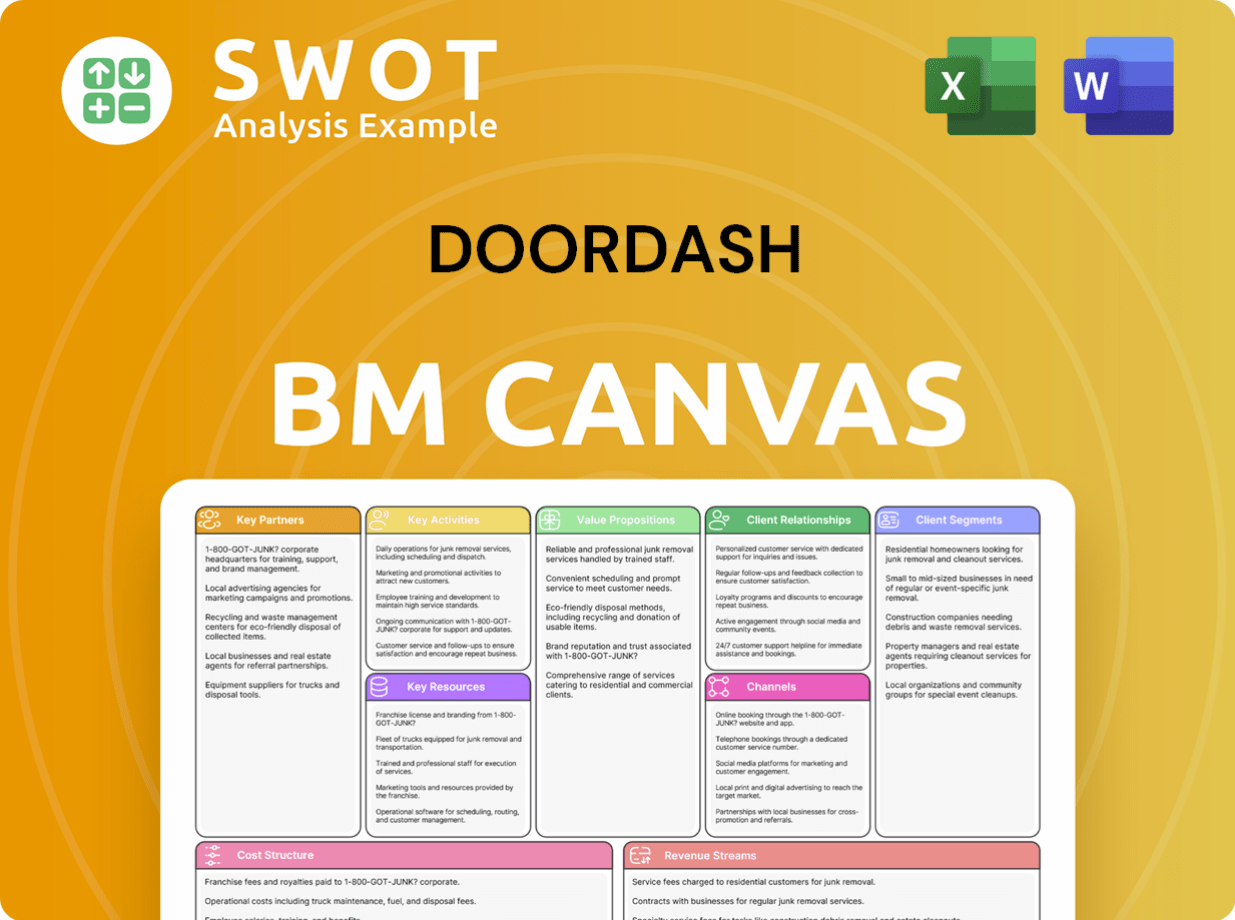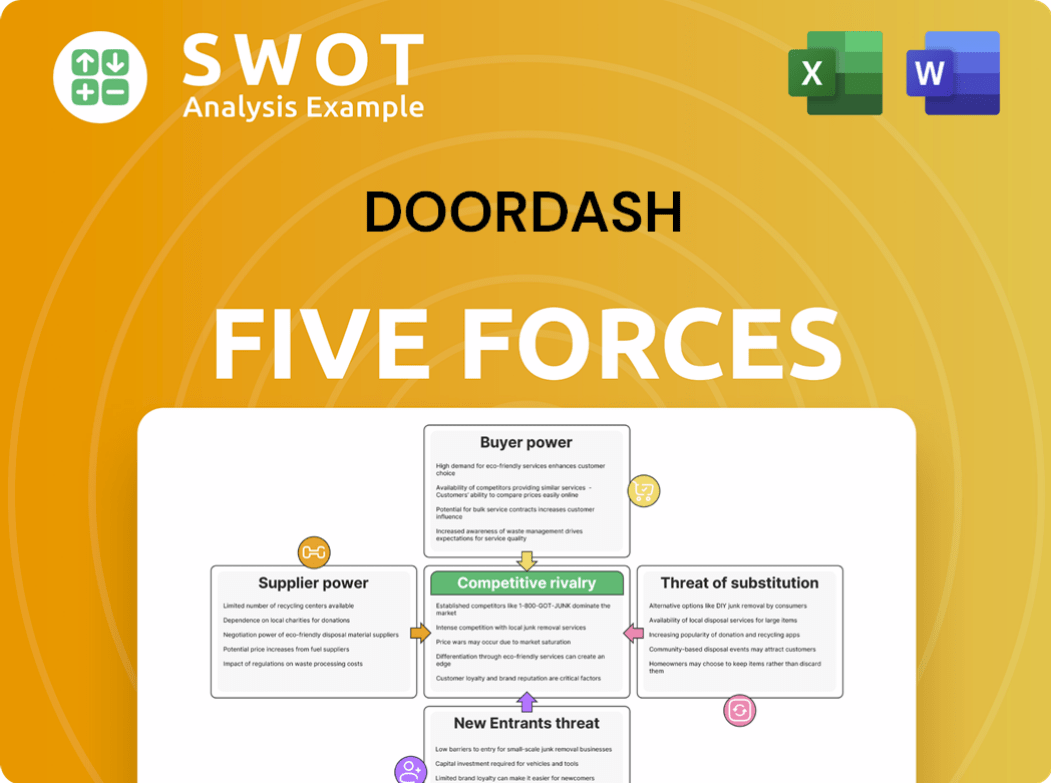DoorDash Bundle
How Does DoorDash Dominate the Delivery App Landscape?
DoorDash's journey from a startup to a market leader has reshaped the on-demand delivery sector, making it a fascinating case study in competitive strategy. Founded in 2013, DoorDash initially focused on empowering local businesses with a robust logistics platform. Today, it's a dominant force, but how does it stack up against the DoorDash SWOT Analysis?

This analysis delves into the DoorDash competition, examining its rivals, and dissecting its strategies within the food delivery services market. We'll explore the DoorDash market analysis, including its strengths and weaknesses in comparison to its competitors. Understanding the delivery app landscape is crucial, and this deep dive will provide insights into DoorDash's competitive advantage and its future in a dynamic market.
Where Does DoorDash’ Stand in the Current Market?
DoorDash holds a significant market position in the U.S. restaurant food delivery sector. The company's core operations revolve around its platform, which connects customers with a vast network of restaurants, grocery stores, and other local retailers. This extensive network is a key component of DoorDash's value proposition, offering convenience and a wide variety of choices to its users.
The company's value proposition centers on providing convenient and efficient delivery services. DoorDash allows customers to order food and other items from local businesses and have them delivered directly to their doorstep. This convenience, combined with a broad selection of merchants, is a primary driver of its market success. DoorDash also provides delivery solutions for businesses, enhancing their operational efficiency.
DoorDash leads the U.S. meal delivery market. As of February 2024, it held a market share of 67%. This substantial lead over its competitors underscores its strong market position. This market share is a key factor in the DoorDash competitive landscape analysis 2024.
DoorDash has a wide geographic presence. It operates across the United States, Canada, and Australia. The company is also exploring expansion into other international markets. This expansion strategy is a key part of DoorDash's growth.
DoorDash serves a broad customer base. It caters to individual consumers seeking convenient meal options. The company also provides services to businesses needing efficient last-mile delivery solutions. This dual approach enhances its overall market reach.
DoorDash's financial health reflects its market dominance. In Q4 2023, the company reported $2.9 billion in total revenue. This represents a 27% year-over-year increase. The company also handled a record 543 million orders in Q4 2023, a 23% year-over-year growth.
DoorDash has strategically shifted its focus. It has moved from solely food delivery to a broader 'new convenience' category. This includes grocery, alcohol, and retail delivery. This diversification is a key element of its competitive strategy.
- Investment in DashMart dark stores.
- Partnerships with major grocery chains.
- Focus on expanding non-restaurant delivery services.
- Continued exploration of less saturated markets.
DoorDash SWOT Analysis
- Complete SWOT Breakdown
- Fully Customizable
- Editable in Excel & Word
- Professional Formatting
- Investor-Ready Format

Who Are the Main Competitors Challenging DoorDash?
Understanding the DoorDash competition is crucial for assessing its market position and growth potential. The on-demand delivery sector is highly competitive, with several key players vying for market share. This analysis provides a detailed look at DoorDash competitors and the dynamics shaping the delivery app landscape.
DoorDash market analysis reveals a complex web of direct and indirect competitors. These rivals employ various strategies, from aggressive pricing to exclusive partnerships, to gain an edge. The competitive environment necessitates continuous innovation and adaptation to maintain a leading position.
Direct competitors offer similar services, primarily restaurant food delivery. This segment is characterized by intense competition, with companies constantly striving to capture a larger share of the market.
Uber Eats is a major direct competitor, holding approximately 23% of the U.S. meal delivery market share as of February 2024. Uber's extensive logistics network and brand recognition provide a significant advantage.
Grubhub remains a significant player, particularly in urban areas, despite a decline in market share. It focuses on long-standing restaurant partnerships and loyalty programs to retain customers.
Indirect competitors operate in related segments, such as grocery delivery and last-mile logistics. These companies compete for a share of the overall delivery market, expanding the competitive landscape.
Instacart is a key indirect competitor, specializing in grocery delivery. It has established partnerships with numerous supermarkets, making it a strong contender in the grocery segment.
Established logistics companies and emerging local delivery services also compete with DoorDash. These entities often focus on specific niches or delivery models.
The DoorDash competitive landscape analysis 2024 highlights several key competitive strategies. These include securing exclusive restaurant partnerships, aggressive marketing campaigns, and technology-driven innovations to improve delivery efficiency. The ongoing rivalry is intense.
- Exclusive Partnerships: Securing exclusive deals with popular restaurant chains is a significant competitive advantage.
- Delivery Speed: Faster delivery times are a critical factor in attracting and retaining customers.
- Pricing Strategies: Competitive pricing and promotional offers are used to gain market share.
- Technological Innovation: Investing in technology to improve delivery efficiency and customer experience.
The entry of new players and potential mergers continue to reshape the market. To learn more about the DoorDash business model competition and its revenue streams, read Revenue Streams & Business Model of DoorDash.
DoorDash PESTLE Analysis
- Covers All 6 PESTLE Categories
- No Research Needed – Save Hours of Work
- Built by Experts, Trusted by Consultants
- Instant Download, Ready to Use
- 100% Editable, Fully Customizable

What Gives DoorDash a Competitive Edge Over Its Rivals?
Understanding the competitive landscape for food delivery services requires a deep dive into the strategies and advantages of key players. DoorDash, a leading company in this sector, has cultivated several core strengths that set it apart from its rivals. Examining these competitive advantages is crucial for a comprehensive DoorDash market analysis and understanding its position in the delivery app landscape.
DoorDash's success is rooted in its ability to efficiently connect consumers with a wide array of restaurants and other businesses, offering convenient delivery options. This has allowed it to capture a significant share of the market. The company's operational strategies, technological innovations, and strategic partnerships all contribute to its sustained competitive edge in the dynamic food delivery services industry.
The competitive dynamics within the food delivery market are constantly evolving. DoorDash must continuously adapt to changing consumer preferences and technological advancements to maintain its market position. This includes refining its logistics network, enhancing its platform, and expanding its service offerings to stay ahead of the competition.
DoorDash's robust logistics network, powered by proprietary technology, is a key competitive advantage. This network, which includes a vast fleet of Dashers and sophisticated routing algorithms, enables DoorDash to offer competitive delivery times and extensive geographic coverage. This efficiency allows DoorDash to handle a large volume of orders effectively.
DoorDash benefits from strong network effects, particularly in the U.S. market. A larger selection of restaurants attracts more customers, which in turn attracts more Dashers. This creates a positive cycle that reinforces DoorDash's market position. The company's scale allows for more efficient operations and potentially lower delivery costs per order.
DoorDash has built a strong brand and customer loyalty through consistent service and effective marketing. The company's user-friendly platform and continuous product innovation, such as DashPass, enhance customer stickiness. These efforts have made DoorDash a recognizable name in the food delivery market.
DoorDash has formed strategic partnerships with a wide array of restaurants, including exclusive agreements with major chains. These partnerships provide a diverse selection of options that appeal to a broad customer base. This helps DoorDash maintain a competitive edge in the face of its DoorDash competitors.
DoorDash's competitive advantages are multifaceted, including its extensive logistics network, strong network effects, brand equity, and strategic partnerships. The company's ability to leverage data analytics to optimize operations and personalize customer experiences further enhances its position. The company has shown significant market share growth, with recent reports indicating that it holds a substantial portion of the food delivery market.
- Extensive Logistics Network: Efficient delivery operations and broad geographic coverage.
- Strong Network Effects: More restaurants attract more customers and Dashers.
- Brand Equity and Customer Loyalty: Consistent service and a user-friendly platform.
- Strategic Partnerships: Exclusive agreements with major restaurant chains.
DoorDash Business Model Canvas
- Complete 9-Block Business Model Canvas
- Effortlessly Communicate Your Business Strategy
- Investor-Ready BMC Format
- 100% Editable and Customizable
- Clear and Structured Layout

What Industry Trends Are Reshaping DoorDash’s Competitive Landscape?
The on-demand delivery industry, where DoorDash operates, is experiencing significant shifts. These changes are driven by technological advancements, evolving consumer preferences, and regulatory pressures. Understanding these trends is crucial for assessing DoorDash's competitive position and future prospects. A thorough DoorDash market analysis reveals a dynamic environment shaped by both opportunities and challenges.
DoorDash faces a complex competitive landscape. The company must navigate challenges such as increasing competition from established players and new entrants, along with regulatory changes impacting labor practices and data privacy. Simultaneously, DoorDash can capitalize on opportunities like international expansion and product diversification to ensure sustained growth. The DoorDash competition is fierce, requiring continuous adaptation and innovation.
Technological advancements, particularly in AI and automation, are crucial. These advancements can optimize logistics, potentially leading to drone or robotic deliveries. Consumer demand is shifting towards faster delivery times and broader product selections. Sustainability is also becoming a key factor influencing consumer choices.
Regulatory changes concerning gig economy worker classification and data privacy pose ongoing challenges. Increased competition from new market entrants and existing players through mergers and acquisitions is a constant threat. Declining demand in a post-pandemic world and increased scrutiny over labor practices could negatively affect profitability.
Expansion into emerging international markets offers significant growth potential, as the penetration of on-demand delivery is still low. Product innovation, such as expanding into new retail categories, presents opportunities. Strategic partnerships and the integration of new technologies like generative AI can enhance customer service and operational efficiency.
DoorDash needs to focus on continuous technological innovation, expansion into new verticals and geographies, and a strong emphasis on customer and merchant loyalty. The company should aim to diversify its logistics platform to remain resilient. The DoorDash competitors continuously adapt their strategies, requiring DoorDash to stay ahead.
DoorDash must leverage technology for efficiency and customer experience. The company needs to diversify its offerings beyond food delivery. Strategic partnerships and international expansion are crucial for growth. For further insights, explore the Marketing Strategy of DoorDash.
- Market Share: DoorDash held approximately 65% of the U.S. food delivery market in early 2024.
- Revenue: DoorDash's revenue for Q1 2024 reached $2.04 billion, a 23% increase year-over-year.
- Active Users: DoorDash reported 32 million monthly active users as of Q1 2024.
- International Expansion: DoorDash is actively expanding in markets like Japan and Germany, aiming to increase its global footprint.
DoorDash Porter's Five Forces Analysis
- Covers All 5 Competitive Forces in Detail
- Structured for Consultants, Students, and Founders
- 100% Editable in Microsoft Word & Excel
- Instant Digital Download – Use Immediately
- Compatible with Mac & PC – Fully Unlocked

Related Blogs
- What are Mission Vision & Core Values of DoorDash Company?
- What is Growth Strategy and Future Prospects of DoorDash Company?
- How Does DoorDash Company Work?
- What is Sales and Marketing Strategy of DoorDash Company?
- What is Brief History of DoorDash Company?
- Who Owns DoorDash Company?
- What is Customer Demographics and Target Market of DoorDash Company?
Disclaimer
All information, articles, and product details provided on this website are for general informational and educational purposes only. We do not claim any ownership over, nor do we intend to infringe upon, any trademarks, copyrights, logos, brand names, or other intellectual property mentioned or depicted on this site. Such intellectual property remains the property of its respective owners, and any references here are made solely for identification or informational purposes, without implying any affiliation, endorsement, or partnership.
We make no representations or warranties, express or implied, regarding the accuracy, completeness, or suitability of any content or products presented. Nothing on this website should be construed as legal, tax, investment, financial, medical, or other professional advice. In addition, no part of this site—including articles or product references—constitutes a solicitation, recommendation, endorsement, advertisement, or offer to buy or sell any securities, franchises, or other financial instruments, particularly in jurisdictions where such activity would be unlawful.
All content is of a general nature and may not address the specific circumstances of any individual or entity. It is not a substitute for professional advice or services. Any actions you take based on the information provided here are strictly at your own risk. You accept full responsibility for any decisions or outcomes arising from your use of this website and agree to release us from any liability in connection with your use of, or reliance upon, the content or products found herein.